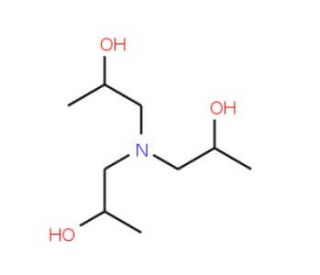

Molecular structure of Triisopropanolamine, CAS Number: 122-20-3
Triisopropanolamine (CAS 122-20-3)
Alternate Names:
1,1′,1′′-Nitrilotri(-2-propanol); Tris(2-hydroxypropyl)amine
CAS Number:
122-20-3
Molecular Weight:
191.27
Molecular Formula:
C9H21NO3
For Research Use Only. Not Intended for Diagnostic or Therapeutic Use.
* Refer to Certificate of Analysis for lot specific data.
QUICK LINKS
Ordering Information
Description
Technical Information
Safety Information
SDS & Certificate of Analysis
Triisopropanolamine, a surfactant, possesses the remarkable capability to lower the surface tension of water, resulting in the formation of micelles. These micelles, small spherical structures, consist of molecules exhibiting mutual attraction. Through this formation, micelles readily engage with proteins and other molecules, enabling their dispersion within a solution. Moreover, Triisopropanolamine can establish hydrogen bonds with proteins, influencing their structure and function in a significant manner.
Triisopropanolamine (CAS 122-20-3) References
- Determination of sialic acids in biological fluids using reversed-phase ion-pair high-performance liquid chromatography. | Siskos, PA. and Spyridaki, MH. 1999. J Chromatogr B Biomed Sci Appl. 724: 205-12. PMID: 10219660
- Effects of a herbicide formulation, Tordon 75D, and its individual components on the oxidative functions of mitochondria. | Oakes, DJ. and Pollack, JK. 1999. Toxicology. 136: 41-52. PMID: 10499849
- Polarographic and voltammetric investigations of new catalytic systems of iron for application in trace analysis. | Zarecedil;bski, J. 1996. Anal Bioanal Chem. 356: 299-302. PMID: 15048373
- Preliminary evaluation of interactions between selected alcoholamines and model skin sebum components. | Musial, W. and Kubis, A. 2006. Chem Pharm Bull (Tokyo). 54: 1076-81. PMID: 16880647
- Organic Chemical Characterization and Mass Balance of a Hydraulically Fractured Well: From Fracturing Fluid to Produced Water over 405 Days. | Rosenblum, J., et al. 2017. Environ Sci Technol. 51: 14006-14015. PMID: 29132208
- Architectured design of superparamagnetic Fe3O4 nanoparticles for application as MRI contrast agents: mastering size and magnetism for enhanced relaxivity. | Pereira, C., et al. 2015. J Mater Chem B. 3: 6261-6273. PMID: 32262745
- Effect of TIPA on mechanical properties and hydration properties of cement-lithium slag system. | Zhang, T., et al. 2020. J Environ Manage. 276: 111274. PMID: 32911386
- Robust Biological Hydrogen-Bonded Organic Framework with Post-Functionalized Rhenium(I) Sites for Efficient Heterogeneous Visible-Light-Driven CO2 Reduction. | Yu, B., et al. 2021. Angew Chem Int Ed Engl. 60: 8983-8989. PMID: 33496055
- Detection of alkanolamines in liquid cement grinding aids by HPLC coupled with evaporative light scattering detector. | Li, C., et al. 2021. Turk J Chem. 45: 430-435. PMID: 34104054
- Coupling Suspect and Nontarget Screening with Mass Balance Modeling to Characterize Organic Micropollutants in the Onondaga Lake-Three Rivers System. | Wang, S., et al. 2021. Environ Sci Technol. 55: 15215-15226. PMID: 34730951
- An efficient and robust HPLC method to determine the sialylation levels of human epithelial cells. | Kim, HJ., et al. 2022. PLoS One. 17: e0257178. PMID: 35041670
- The complicating role of pnictogen bond formation in the solution-phase and solid-state structures of the heavier pnictogen atranes. | Moaven, S., et al. 2022. Dalton Trans. 51: 11335-11339. PMID: 35796284
- Hydrogen-Bonded Organic Framework Ultrathin Nanosheets for Efficient Visible-Light Photocatalytic CO2 Reduction. | Yu, B., et al. 2022. Angew Chem Int Ed Engl. 61: e202211482. PMID: 36068668
- Effect of Polycarboxylic Grinding Aid on Cement Chemistry and Properties. | Yang, J., et al. 2022. Polymers (Basel). 14: PMID: 36146050
Ordering Information
| Product Name | Catalog # | UNIT | Price | Qty | FAVORITES | |
Triisopropanolamine, 25 g | sc-272720A | 25 g | $38.00 | |||
Triisopropanolamine, 500 g | sc-272720 | 500 g | $56.00 | |||
Triisopropanolamine, 1 kg | sc-272720B | 1 kg | $93.00 |
